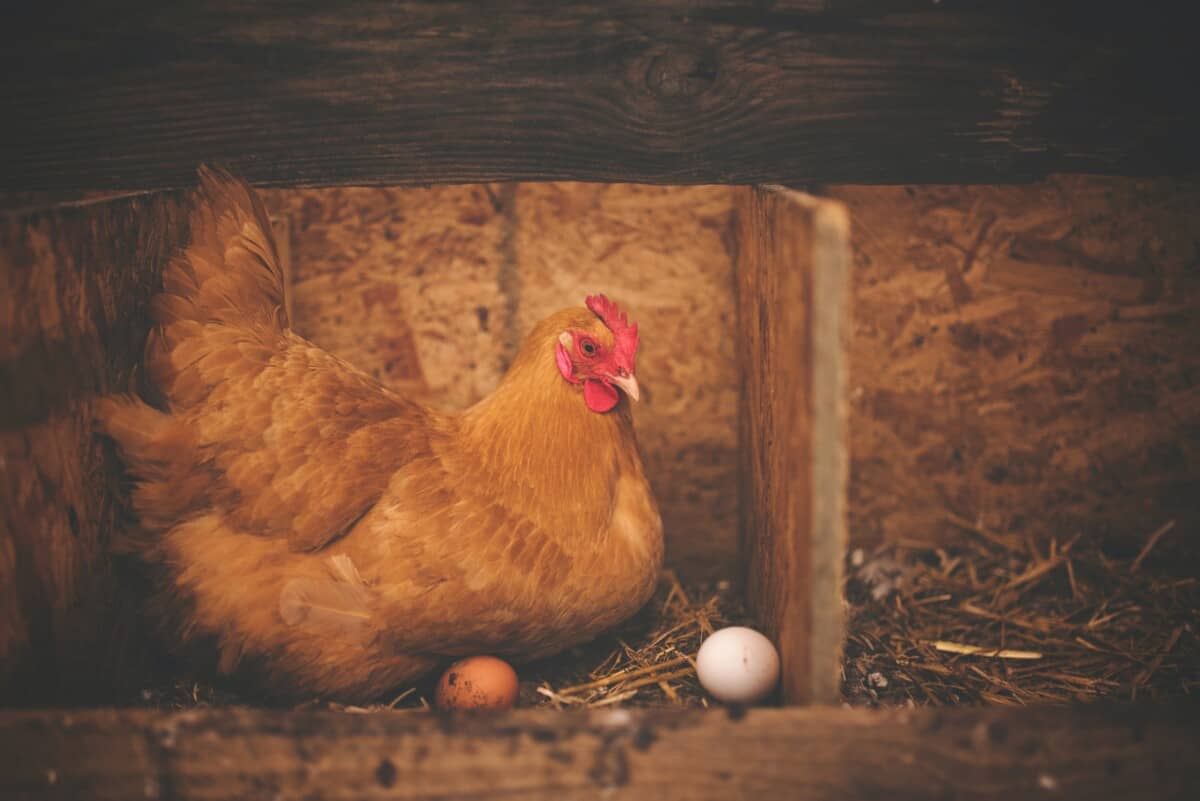If you are considering raising chicks then there are some things to consider. You should check your local town’s city ordinances to make sure that raising chickens is even allowed in your neighbourhood. They may even determine how many chickens you can keep. If you live outside city limits, then you may not have to even worry about those laws.
Make sure that you have enough space. A chicken coop needs room for a feeder, water containers, and obviously enough space for however many chickens you are thinking of raising. If you are going to hatch your own eggs, then the coop also needs room for a roosting area and a nest box for every three hens.
A proper chicken coop should be large enough that you can stand in it to gather eggs and shovel manure comfortably. Remember to make it sturdy enough to keep out the predators.
Hens will lay eggs through spring, summer, and into the autumn if they have 12 to 14 hours of sunlight. You should expect to collect eggs daily, sometimes even twice a day. Chickens are sociable creatures so you will need at least three birds to keep them healthy.
Which Breed Is Best For You?
Some things you will want to consider is the number and colour of eggs that are produced, the breed’s temperament, noise level, and its adaptability to confinement. Noise level really matters if you live around other people. You might want to know which breed lays the most eggs, best eggs for certain things, or the biggest eggs.
Most Eggs
You may want to produce as many eggs as you can per chicken and below, I have the chickens that produce the largest quantities of eggs. Refer to Table 1 for a summary.
Hybrids
There are many different hybrid breeds and one of the most common is known as the Golden Comet. Hybrids have been bred to lay huge amounts of eggs whilst only consuming small amounts of food. This makes them cheaper to feed than other breeds.
Eggs: You should expect for a typical hybrid hen to lay around 280 eggs per year. These eggs will be medium sized and brown coloured.
Colour: Hybrids are normally a golden, brown colour with soft white tail feathers.
Character: They tend to be a very tough and resilient chicken and rarely ever turn broody. If you are looking for an all year-round egg layer who is easy to look after, a Hybrid chicken is the pick for you.
Rhode Island Red
Rhode Island Red’s originated from America and are known as a ‘dual purpose’ chickens. This means they can be raised for either eggs or meat. They are one of the most popular backyard chicken breeds because they are tough and lay lots of eggs.
Eggs: You should expect a young Rhode Island Red to lay 250 eggs a year. These eggs are brown and medium sized.
Colour: Contrary to their name, Rhode Island Reds have brown and black feathers giving them a dark appearance.
Character: They are more than capable of looking after themselves and are well known for being tough. Rhode Islands are very friendly and are commonly picked by first time chicken keepers.
Leghorn
Leghorns were brought to the States from Italy back in the 1800s and have made the perfect backyard chicken ever since.
Eggs: They should lay around 250 eggs per year. These eggs will be white and medium sized.
Colour: They are one of the most unique breeds going, with a full white body and a large thick red comb.
Character: Whilst they would still make an ideal pick for a beginner, anyone looking to tame their chickens should not choose Leghorns as they are known for being shy and hard to tame.
Largest Eggs
All hens start egg production laying Pee Wee or Small eggs and gradually increase to a mature egg grade size of Medium, Large, or bigger. In modern breeds, most hens are laying Large, Extra Large or Jumbo eggs by 40 weeks of age. Within these breeds, however, it’s important to realize that there are conditions that make any hen lay larger and healthier eggs.
While you cannot alter the basic pattern of how egg size changes as hens age, the feeding and management of your hens can have a measurable impact on egg size and timing of when optimal size will be reached. Refer to Table 2 for a summary.
Minorca
The Minorca is the largest of the Mediterranean breeds of chicken. It has beautiful glossy black plumes and a rich red face with white earlobes. It is also the friendliest and easiest to handle of the Mediterranean breeds. The hens usually lay 200 or more eggs per year and are well known to be some of the largest white eggs of any breed.
Lohmann Brown
Lohmann Brown chickens are one of the best hybrid chickens for egg laying. They were developed by a German genetics company from the selective breeding of New Hampshire chickens with other brown egg laying hens. These chickens are champions at what they do.
Lohmann Browns begin laying jumbo sized eggs after 4-5 months from hatching. You can expect around 300 beautiful brown and exceptionally large eggs a year from your Lohmann Brown hen.
Welsummer
Welsummer were bred as a dual-purpose chicken that laid a lot of large dark reddish-brown eggs (almost terracotta colour) and are also known for quick maturation in the meat category.
Welsummer eggs from adult hens consistently hit the large and extra-large USDA weights, and so combined with their beautiful dark colour, these eggs are a favourite at many local farmer’s markets. Welsummer hens are not, however, excited about cold dark winter months, and will typically slow production during this time.
Building Your Coop
Once you’ve decided on how many and what kind of chickens you want, the next step is to design and build your chicken coop. When designing your chicken coop there are some things to remember. Decide the size, you will need 2 square feet of floor space per chicken.
Do not forget to build in a door and floor. Then you will need to make sure and have ventilation. Once you’ve sketched out your plans and marked the ground it’s time to start building.
- When you are ready, bring your plans to the lumber yard. Someone there can help you determine how much stock and what tools and/or equipment you will need. Plan to frame the chicken coop with 2-by-4s and use sheets of plywood for the walls. The roof can be a sheet of plywood covered with roof shingles, or simply a piece of sheet metal.
- A 5×20-foot run will keep a small flock, six to eight hens happy. More space is better if you have the room. If predators are a problem in your area, bury a layer of chicken wire 6 inches deep under both the coop and the run-in order to foil diggers like foxes, dogs, and skunks or badgers. Minks and weasels can slip through standard 2-inch wire. To keep them out, use a couple of 2-inch layers offset or 1-inch wire instead. Plug any holes in the coop walls as well.
- You’ll need to accessorize the chicken coop, at least rudimentarily: Waterers, available from farm suppliers, keep the chickens from fouling their water supply. Get one for every three or four chickens. Also get a feed trough long enough to let all the chickens feed at once (or get two smaller ones). Learn more about chicken feed. Have enough wood shavings (pine) or straw to put a 6-inch layer on the floor and a couple of handfuls in each nest box and your chickens will have a perfect home. Change the bedding about once a month or if it starts looking flat.
Once you have eaten farm-fresh eggs, it’s hard to go back to grocery store eggs. Fresh farm eggs, free-range or not, are delicious, with bright yolks and firm whites. Give your hens ground oyster shell or a similar calcium supplement, available at farm suppliers, for strong eggshells.
You will want to collect eggs every morning; hens cackling loudly are a sign or clue that they are laying. You can tell what colour eggs a hen will lay by the colour of her ear. Yes, her ear. Birds do not have external ears like humans do, so look for a small circle or oval of skin on the side of the head, next to the ear hole. If it’s white, your hen will lay white eggs; if it’s red, she’ll lay brown ones. There is no difference in flavour or nutrition.
Eggshells have a “bloom,” a natural coating that protects the egg from bacteria. Avoid washing your eggs if you can; instead, wipe with a dry, rough cloth.
If the eggs have a little manure on them, you can wipe with a damp cloth for small spots. A dirty egg can be submerged and scrubbed with a vegetable brush. Always use warm water; cold water will make the egg shrink inside the shell and will draw in bacteria. Let eggs air-dry thoroughly before putting them away.
| Species | Quantity of Eggs/Year | Character |
| Hybrid | 280 | Resilient and not broody |
| Rhode Island Red | 250 | Independent and friendly |
| Leghorn | 250 | Shy and timid |
| Species | Quantity of Eggs/Year | Size of Eggs |
| Minorca | 200 | Largest White Eggs |
| Lochmann Brown | 300 | Large Brown Eggs |
| Welsummer | 160 | Extra Large Brown |

